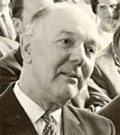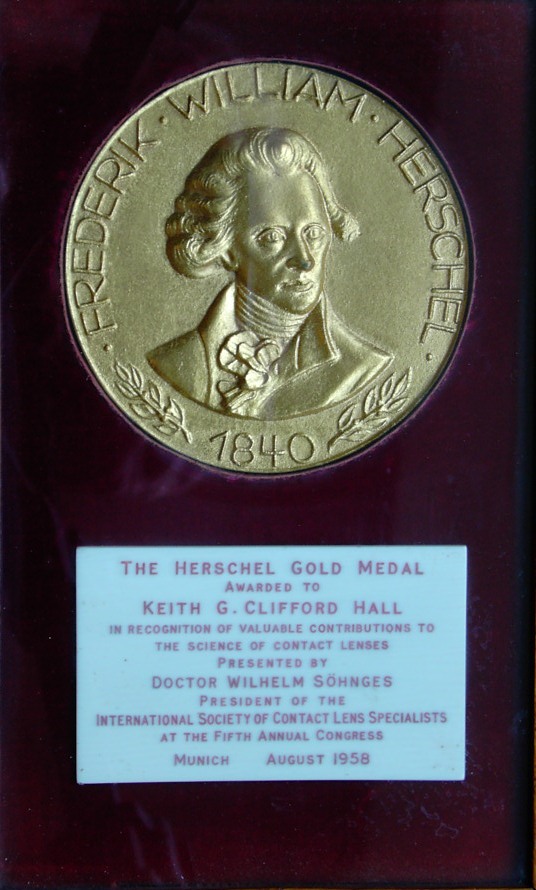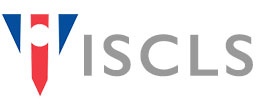Friendship has always been, and continues to be, the cornerstone of the ISCLS. Started in 1953, just seven years after the end of World War II, it was the world’s first international contact lens society, and a great testament to the power of personal friendship overcoming cultural and national suspicions and reservations.

The first friendship on which the society was based started in 1938 with the visit of Frank Dickinson (photo at left), an optometrist from St Anne’s in Lancashire, U.K. to Berlin in Germany. It was there that he and Wilhelm (Billy) Söhnges first met and exchanged ideas on contact lenses and contact lens design. They kept in touch when they could but this was somewhat hampered by the declaration of a state of war between Britain and Germany on 3rd September 1939. However this state of affairs led to the meeting during the war of Frank Dickinson and Jack Neill, an American optometrist, at a U.S. air base near St Anne’s.
It was not until a meeting of the International Optical League in London in 1951 that all three met. They discussed their separate lines of research and found they were all working on similar ideas. They pooled their resources, which led to the launch of the micro-corneal lens in 1952.
After the war Söhnges moved from Berlin, where he had previously established four practices, to Munich where he established another optical practice specialising in the fitting of contact lenses. He bought an estate at Urfahn-am-Chiemsee in Bavaria with a large if somewhat dilapidated house. In August 1953 Frank and his son Peter visited Billy who explained his ideas of using the house as a study centre for those interested in making and fitting contact lenses. From this arose the idea of forming an international group of contact lens practitioners who could meet at the house in a social atmosphere and discuss mutual problems and ideas.
Billy immediately put in hand renovations to the house converting the upper floor of an octagonal tower at the house into a lecture room for the congresses. By 1955 five or six newcomers were welcomed to their discussions in the now enlarged house which featured extensive grounds, a boat house by the lakeside and also a Finnish bathroom. Days often started and ended with a dip in the lake and so started the ongoing theme of mixing work and recreation allowing informal discussions between friends.
It became clear that space was limited so it was decided to restrict the number of members initially to 25, later rising to 30, with emphasis on representation from many different countries. In August 1959 the congress was held in London with the following meeting in 1962 being held in Philadelphia. However there was continuous exchange of views between members by correspondence and personal visits well before the advent of mobile phones and emails. Today full membership is still limited; however a wider representation of the profession has been encouraged through associate membership. Members are leading practitioners in contact lenses from optometric, medical, and manufacturing backgrounds from Europe, North and South America, Australia, Scandinavia, Asia, and Great Britain.
The Society continues to hold congresses on an 18 month programme with two European events being followed by one in the Americas. In the words of Dr. E. Ward Ewalt Jr., president of the American Optometric Association in 1962, “the assembly was indeed a classic example of what can be achieved by men of good will from many nations united in their interest in scientific development.”
ISCLS Herschel Medal

The Herschel Medal was the brainchild of Wilhelm Söhnges soon after the founding, in 1954, of the ISCLS. The name of Herschel was chosen due to his contribution to the principle of contact lenses in his treatise Light, in 1827, and was to be awarded for outstanding services to contact lenses. However, the medal bears the name and image of Sir Frederick William Herschel, the discoverer of Uranus. In fact he had nothing to do with contact lenses; it was his son Sir John Herschel. This was brought to the attention of the ISCLS in a congress presentation in 2006. The confusion started in correspondence between Frank Dickinson and Wilhelm Söhnges in 1957.
Since 2006 it has been known simply as the Herschel medal. Initially there were two versions, the Gold medal was in recognition of work by a practitioner and the Silver to one engaged in some allied or associated field. Only two silver medals have ever been presented. The first recipients of the medal were Frank Dickinson and Jack Neill co-founders of the ISCLS with Wilhelm Söhnges. Frank and Jack were against the idea of being presented with the medal unless Wilhelm received one as well. Wilhelm was adamant that other, more deserving people should be awarded the medal well before himself. However Frank and Jack got their way in 1959 when the congress was held in London and they made it clear to Wilhelm that he had no choice in the matter!
Herschel Medal Recipients
The Herschel Gold Medal is awarded “in recognition of outstanding original contributions to contact lens design techniques and of fitting and application in clinical practice, in the education of students and in the advancement of the status of contact lens practice. A gold medal may also be awarded for valuable contributions to the science of contact lenses by those outside the ophthalmic profession.” Memorandum and Articles of Association
- Frank Dickinson 1957
- Jack Neill 1957
- Ernst von Khuon Silver 1957
- Keith Clifford Hall 1958
- Robert Graham 1958
- Wilhelm Söhnges 1959
- George Giles Silver 1959
- Bill Feinbloom 1962
- George Jessen 1964
- Peter Mϋller 1964
- Newton K Wesley 1969
- Bill Policoff 1973
- Hermann Kemmetmuller 1973
- Ted Bayshore 1976
- Leslie Evershed-Martin 1976
- Bruno Miller 1976
- Freddie Burnett Hodd 1976
- Theo Gumpelmayer 1978
- Heinz Baron 1982
- Maurice Poster 1982
- John de Carle 1984
- Bud Braff 1985
- Irving Fatt 1985
- Harold Davis 1988
- Pierre Rocher 1988
- Erwin Voss 1988
- Carlos Tellez 1990
- Bob Koetting 1991
- Jack Kennedy 1993
- Newton K Wesley 1993
- Sheldon Wechsler 1994
- Golf Iverson 1996
- Irving Borish 1999
- Wakako Iwasaki 2000
- Nigel Burnett Hodd 2000
- Richard M Hill 2003
- Brigitte Lutcher 2003
- Ivan Wainer 2005
- Don Ezekiel 2005
- David Evershed Martin 2005
- Jerry Garber 2008
- William Joe Benjamin 2008
- Mel Remba 2009
- Richard Davis 2011
- Frank Petticrew 2012
- Joshua Josephson 2012
- Ralph Stone 2014
- Ken Polse 2015
- Caroline Burnett Hodd 2018
- Damon Ezekiel 2018
- Michael Bärtschi 2023
- Armin Duddek 2023
- Helmer Schweizer 2023
- Rick Weisbarth 2023
- Greg DeNaeyer 2023
Worthy of note is that Newton K Wesley, co-founder of Wesley Jessen, is the only person to have been awarded the medal twice. Nigel Burnett Hodd, David Evershed Martin and Richard Davis are all recipients following in their fathers’ footsteps. Pierre Rocher and Brigitte Lutcher are the only married couple to be awarded medals individually.
